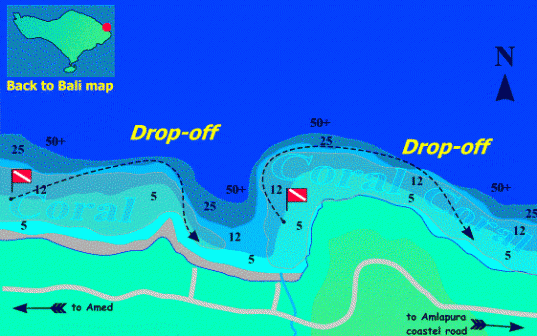Amed
Amed has remained us a little village at northeast coastal regent with dry volcanic rock ridges along its coastline. It is about 10 km south of Tulamben bay, at Culik regency, there is -Cemeluk bay- with black volcanic sandy beach offers two diving sites, Uyah reef (salt) and Cemeluk reef. Beyond this bay further east some more diving points Bunutan reef (Garden ell) and Lipah reef, Bali’s eastern most point.
Amed Uyah Reef
It takes 15 minutes on a small local outrigger fishing boat, with maximum capacity of 5 persons on board to reach these reefs. The reef in the shallows is not worth to dive, rubble outcrop was seriously damaged by the El-Nino in 1988, but at the steep slope and the deep jagged wall is still in excellence condition, from 15 meters to over 50 meters is charming colourful reef wall. A variety of reef fishes from small to large pelagic, White tip reef sharks, graceful Banner fishes, black Snappers, Humpback snappers and a lot more are common seen. Some divers have reported schools of Bumphead parrotfish swimming across the shallow reef flats. The current is average mild running toward the bay and water temperature is always warm.
Amed Cemeluk Reef
The small outrigger fishing boat powered by outboard engine will take 6 minutes to this reef. Before the El-Nino 1988 bleached the reef in bay, it was the glory time, colourful soft corals, bushy Gorgonians and Staghorn acropora are spreading all over the reef, and was as the best place for snorkellers. Out from the reef in bay is a stretch of gorgeous jagged reef wall where schools of Blue fin trevally, Black and Humpback snappers, large pelagic also visits this reef, Shark, Napoleon wrasse and swarm others reef fish. The edge of reef wall begins at 15 meters, sheer reef wall over 45 meters deep and some bommies spur into bay are interesting with macro critters, Scorpion fish, Nudibranch and a like. The current flows mainly mild with good water clarity and water temperature is always warm 28 C to 29 C.
Amed Bunutan Reef
From the Cemeluk Bay takes 30 minutes on outrigger local fishing boat to a jetty cliff at Bunutan village, off shore is a huge flat white sand bottom at the depth of 10 meters, gradually descending to 18 meters. Large numbers of graceful Garden ells jutting out from the sand, with good clarity and sun light they look absolutely breathtaking. The extending reef ridges are the outmost tips of Bali, spreading out from Garden ells on the steep slope to the maximum depth of 35 meters is gorgeous and healthy reef with variety of macro sea life and large pelagic fish. Huge barrel sponges and Gorgonians dominated this reef; in a single sponge you can find sheltering a number of Lionfish, Shrimps, Worms, Nudibranch and other varieties of macro sea life. Due the reef deeps a close eye needs to be kept on your dive computer. The current from the Lombok strait can sometimes affect planned dives here. Water temperature is normally around 28 C but the up currents can drop the water temperature.
Amed Lipah Bay
This bay is situated at the eastern tip of Bali, to dive in this bay is more convenient from a small outrigger boat provided by local fishermen, the reef ridges spurs out into the bay and the current from Lombok strait can pick up making it difficult swimming back to the bay. In the bay lies a small Japanese freighter ship, 12 meters long sits at 6 to 12 meters water. The history behind this ship was unknown. Black corals, colourful soft corals and Gorgonians grown well on this ship and attract variety of reef fishes to its shelter. Bommies at 10 meters on the reef slopes are covered with gorgeous bushy Gorgonians and soft corals, good numbers of reef fishes, then the reef runs away down the slope out of the bay over 30 meters deep. Schools of Jack and Blue fin trevally often are encountered in this site. In the bay at slope sandy bottom is good place to see unusual animals, like Shrimps, Ghost pipefish, Dragonet fish, Sand diver fishes, Gobies, Devil scorpion and others. Water temperature is roughly 29 C. It can be lower if up currents affect the dive site. When strong wind blows from southeast the wave will swirl the sandy bottom cause the visibility is blur, mostly the clarity is good.

